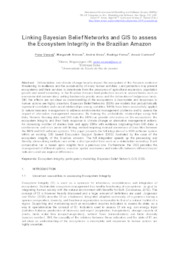Linking bayesian belief networks and GIS to assess the ecosystem integrity in the brazilian Amazon.
Linking bayesian belief networks and GIS to assess the ecosystem integrity in the brazilian Amazon.
Author(s): VERWEIJ, P.; SIMOES, M.; ALVES, A.; FERRAZ, R.; CORMONT, A.
Summary: Deforestation and climate change heavily impact the ecosystem of the Amazon rainforest threatening its resilience and the sustainability of many human activities. Land protection may prevent ecosystems and their services to deteriorate from the pressures of agricultural expansion, population growth and wood harvesting. In the Brazilian Amazon land protection occurs in several forms such as environmental conservation, setting biodiversity priority areas and the delineation of indigenous lands. Still, the effects are not clear as understanding of the ecosystems is incomplete and responses to human actions are highly uncertain. Bayesian Belief Networks (BBN) are models that probabilistically represent correlative and causal relationships among variables. BBNs have been successfully applied to natural resource management to address environmental management problems and to assess the impact of alternative management measures. By training the probabilistic relationships using field data, Remote Sensing data and GIS data the BBN can provide information on the ecosystems: the ecosystem integrity and their likely response to climate change or alternative management actions. An increasing number of studies train and apply BBNs with evidence originating from GIS data; a cumbersome and error prone soft-linking method requiring manual conversion of data files between the BBN and GIS software systems. This paper presents the full integration of a BBN software system within an existing GIS based Discussion Support System (DSS) illustrated by the case of the ecosystem integrity of the Brazilian amazon. The full integration speeds up the processing and thereby allows doing multiple runs within a short period of time such as a stakeholder workshop. Each consecutive run is based upon insights from a previous one. Furthermore, the DSS provides the management of different options, visualize spatial summaries and trade-offs between different impact indicators and see regional differences.
Publication year: 2014
Types of publication: Paper in annals and proceedings
Unit: Embrapa Soils
Observation
Some of Embrapa's publications are published as ePub files. To read them, use or download one of the following free software options to your computer or mobile device. Android: Google Play Books; IOS: iBooks; Windows and Linux: Calibre.
Access other publications
Access the Agricultural Research Database (BDPA) to consult Embrapa's full library collection and records.
Visit Embrapa Bookstore to purchase books and other publications sold by Embrapa.

